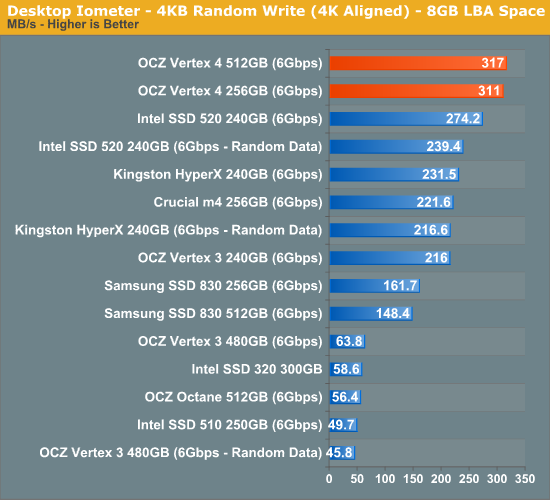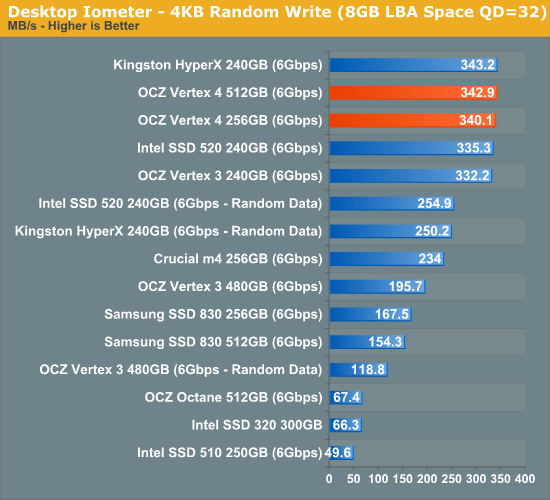OCZ Vertex 4 Review (256GB, 512GB)
by Anand Lal Shimpi on April 4, 2012 9:00 AM ESTRandom Read/Write Speed
The four corners of SSD performance are as follows: random read, random write, sequential read and sequential write speed. Random accesses are generally small in size, while sequential accesses tend to be larger and thus we have the four Iometer tests we use in all of our reviews.
Our first test writes 4KB in a completely random pattern over an 8GB space of the drive to simulate the sort of random access that you'd see on an OS drive (even this is more stressful than a normal desktop user would see). I perform three concurrent IOs and run the test for 3 minutes. The results reported are in average MB/s over the entire time. We use both standard pseudo randomly generated data for each write as well as fully random data to show you both the maximum and minimum performance offered by SandForce based drives in these tests. The average performance of SF drives will likely be somewhere in between the two values for each drive you see in the graphs. For an understanding of why this matters, read our original SandForce article.
Random read performance is staggering - a good 40% higher than anything else we've tested. While the cutoff for usefulness on a client drive is likely much lower than what even the Octane could deliver, this sort of performance bodes very well for OCZ's enterprise ambitions.
Randomly write performance is also just excellent. SandForce's peak numbers come close, but throw in any sort of incompressible data and they quickly take a step back while the Vertex 4 is able to deliver. Again, I'm actually more interested in these numbers from an enterprise workload standpoint but heavy client users will definitely not be disappointed.
Many of you have asked for random write performance at higher queue depths. What I have below is our 4KB random write test performed at a queue depth of 32 instead of 3. While the vast majority of desktop usage models experience queue depths of 0 - 5, higher depths are possible in heavy I/O (and multi-user) workloads:
SandForce always scaled well at higher queue depths, but again we're looking at best case performance for the SF-2281. Move towards incompressible data and the Vertex 4 is alone at the top.













127 Comments
View All Comments
Kristian Vättö - Wednesday, April 4, 2012 - link
Samsung 830 is "a lot" faster, see our Heavy and Light benches. In real world, you will probably not notice the difference unless you do something I/O intensive. Personally, I've been recommending both Crucial m4 and Samsung 830. Crucial is great if you want to save a few bucks but otherwise Samsung is better. I think Anand has been using the Samsung in his main system for months now and haven't had issues, so that may be a reason as well. After all, we speak based on our own experience.kristof007 - Thursday, April 5, 2012 - link
I've been looking around for articles and just looked at bench marks (ignore the M3 and Vertex 4 reviews) and it seemed like the Crucial m4 was hands down the best drive. I purchased it yesterday via Newegg for $299 (it was on sale). Sounds like I won't be disappointed.I was wondering if you guys could maybe have like a top 3 list for SSDs (or heck .. for all categories) with quick pro's and con's for what is out at the moment and what is the best one performance wise.
By the way, I haven't been reading much AT lately, but I've seen a few of your articles and would like to thank you for your work!
nathanddrews - Wednesday, April 4, 2012 - link
The 830 offers up nearly the best "real world" disk busy performance in both the light and heavy benchmarks and has proven to be extremely reliable and consistent without being very expensive. The M4 is great... but a bit outdated performance-wise (not as fast as the 830).antef - Wednesday, April 4, 2012 - link
Thanks for the replies. I guess I saw them as trading places a good bit in the benchmarks, but I do see that the 830 often comes out on top. I guess I figured the performance difference is practically nil for mainstream uses and the M4 seems more highly reviewed. But the 830 has been out for less time, so that may improve over time.nathanddrews - Wednesday, April 4, 2012 - link
That's just it - the differences in overall performance aren't likely to keep one awake at night. In the case of a person that has never used an SSD, just about any SSD available online today will completely shock and awe.An SSD that is 20% faster than another SSD which are both 900% faster than a 5400RPM HDD... not a big deal.
antef - Wednesday, April 4, 2012 - link
"Shock and awe" is the correct way to describe my feelings the first time I saw Windows boot in 3 seconds. :)beginner99 - Wednesday, April 4, 2012 - link
Price wise for average user the m4 is the best bang for the buck. Here its the cheapest sata-3 128 GB drive and 20$ cheaper than the Samsung. Also m4 uses less power, eg better for a laptop.ExarKun333 - Wednesday, April 4, 2012 - link
Looks like a trade-off that gave-up read performance for write performance with poor power consumption. Based on the charts, the HyperX 240GB or the Intel 520 would be better all-around options. The OCZ name also doesn't inspire a lot of confidence when it comes to reliability or support. They will really need up their game for customer service this generation to build some confidence in them.alan1476 - Wednesday, April 4, 2012 - link
If you are not impressed by this drive the review did not do this drive justice. If someone reviews a drive especially an SSD you have to understand the inner workings and just how it applys itself to applications in the real world. This SSD is ground breaking.cknobman - Wednesday, April 4, 2012 - link
I see no Sandforce 512gb drives shown in the performance charts.Its pretty common knowledge that SSD performance goes up with capacity and showcasing the Vertex 4 512gb drive against either smaller SSD's or older controllers makes it look better than it likely is.
Did anyone notice the abysmal speeds for the 120gb model???
I also noticed pretty high power consumption.
I don't consider this review proper until you place a 2nd Gen 512gb SandForce drive in the charts to compare directly against the 512gb Vertex 4 drive.